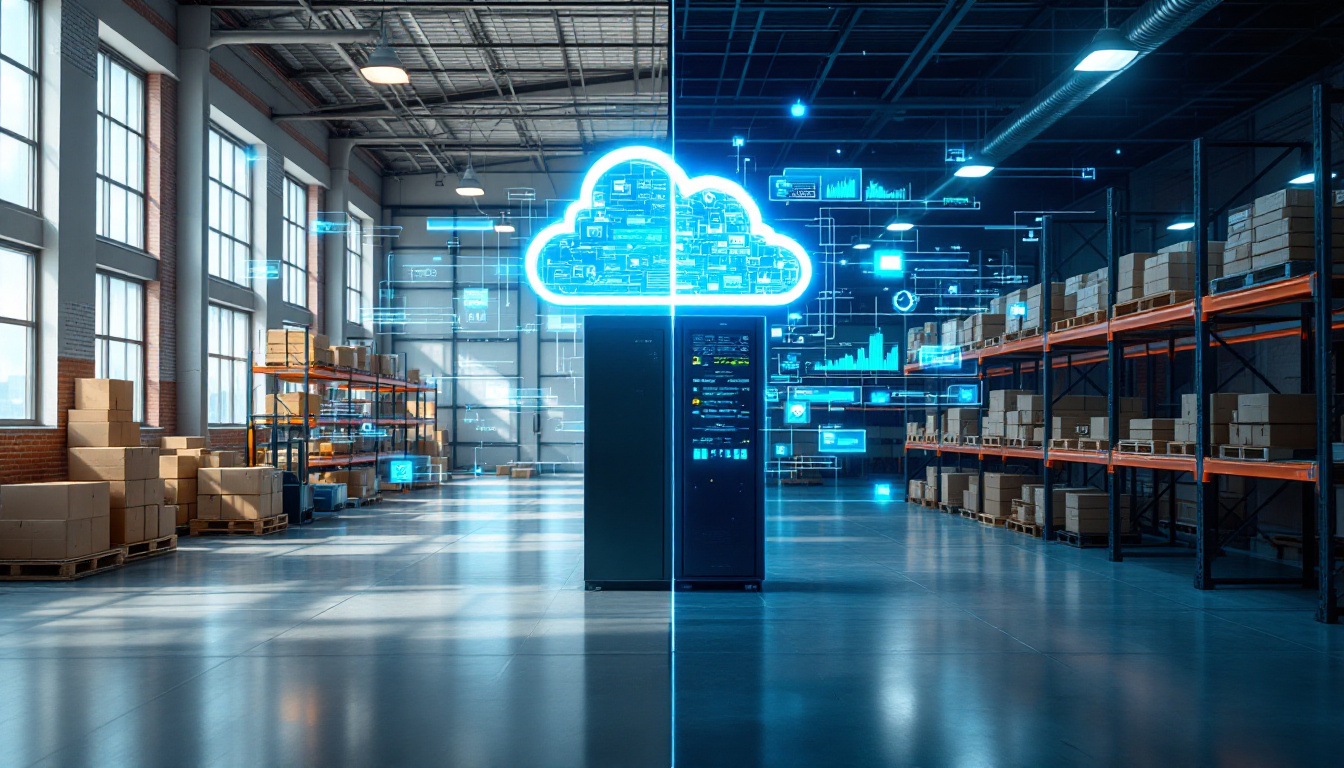Running a warehouse means staying on top of inventory, orders, and logistics. That’s where Warehouse Management Systems, or WMS, step in. These tools help businesses organize, control, and improve daily warehouse tasks. Over the past few years, many companies have moved from on-premises software to Cloud WMS solutions for better flexibility and cost savings.
This shift has sparked fresh debates about which system is best for today’s needs. Cloud WMS offers quick updates and remote access, while traditional on-premises WMS promises greater control. Picking one isn’t always simple, but making the right choice impacts efficiency and your bottom line. If you want to learn more about how a WMS actually works, check out What is a WMS?.
Understanding Warehouse Management Systems (WMS)

If you want your warehouse to run smoothly, you need more than just people and shelves. You need a system dedicated to organizing every step. A Warehouse Management System (WMS) acts as the digital backbone of your entire operation. Whether you run a local shop or a national brand, a good WMS keeps things in order, products moving, and customers happy.
Core Functions of a WMS
A modern WMS does much more than just track what’s in stock. It connects each part of your warehouse, making it easy to follow every item from arrival to departure. The main features include:
- Inventory Tracking: See exactly what you have and where to find it at any moment.
- Order Management: Handle orders as they come in—without delays or errors.
- Picking and Packing: Guide staff through the warehouse with smart paths and packing lists.
- Shipping Coordination: Organize shipments for speed, cost, and accuracy.
- Returns Processing: Simplify returns so they don’t slow down your day-to-day work.
Each function supports accuracy and speed, whether you use a Cloud WMS or an on-premises option.
Why Effective Warehouse Management Matters
Warehouse management goes beyond moving boxes. It shapes your company’s reputation and bottom line. When mistakes happen—stockouts, shipping errors, delays—customers notice. Those mistakes can cost you sales and trust.
A strong WMS lets you:
- Reduce costly errors with real-time data.
- Cut unnecessary labor and save money.
- Spot trends and adjust plans before small issues snowball.
- Keep promises to customers by delivering when and where you said you would.
For a deeper look at what a WMS covers, you can explore What is a WMS?.
The Foundation for Logistics and Business Success
Your warehouse is the heart of the supply chain. If things run well there, your whole business gets stronger. Fast order processing, accurate inventory, and smart shipping decisions help every part of logistics. A modern Cloud WMS helps companies compete—no matter their size—by giving them tools that used to only be available to the big players.
Warehouse success comes from clear organization, smart planning, and data you can trust. With the right WMS, you set your business up to handle more orders, less stress, and future growth.
Key Differences Between Cloud WMS and On-premises WMS
Choosing between Cloud WMS and on-premises WMS comes down to more than just where the software lives. It shapes how your warehouse operates daily, how much time your team spends on IT, and even how fast you can adapt or grow. Below, we break down the main areas where these two options go in different directions.
Deployment and Infrastructure
Setting up a Cloud WMS is a lot like moving into a ready-made apartment—you walk in, customize a few things, and you’re good to go. You don’t worry about rewiring or building walls. Everything runs on your provider’s servers, so you log in through a web browser or app. There’s no need to buy new servers or find space in your facility for extra equipment.
With an on-premises WMS, the process is more like building your own house. You must purchase hardware, install software, and often need IT specialists to configure and maintain your setup. This requires:
- Designing your system architecture.
- Investing in network servers and backup options.
- Handling updates, patches, and possible system upgrades yourself.
For teams with a full IT staff and strict requirements for system control, this can make sense. But for many businesses aiming for quick launch and fewer IT headaches, Cloud WMS is far simpler. To dig deeper into how cloud deployment works and what it can do for your business, the Cloud WMS Guide gives a practical overview.
Maintenance, Security, and Compliance
Maintenance chores and security worries are handled quite differently depending on your WMS choice. With a Cloud WMS, the provider manages software updates, bug fixes, server health, and most security protocols. You don’t need to schedule downtime or stress about keeping systems patched. Updates usually happen automatically and outside work hours, reducing disruption.
On-premises WMS hands over nearly all responsibility to you and your IT team. That means keeping up with security updates, managing firewalls, preventing data breaches, and ensuring your system meets any industry compliance rules. If you operate in a sector with strict audit requirements or handle sensitive data, this can add major complexity.
Adjusting to new regulations is usually quicker with Cloud WMS as the provider implements changes for everyone. For on-premises WMS, you may need to buy new software modules or update infrastructure, leading to possible delays and added costs. If you’re looking for ways to streamline how your WMS connects to other systems and boosts efficiency, the WMS integrations guide is packed with useful tips.
Costs: Upfront and Ongoing
Cloud WMS flips the cost structure compared to on-premises solutions. With the cloud, you pay monthly or annually, similar to a subscription. Upfront costs are minimal, since you’re not buying physical servers or software licenses. As your business scales, you can add users or capacity instantly, usually for a set fee.
On-premises WMS requires a significant investment from day one. You’re paying for software licenses, hardware, installation, and possibly outside IT support:
- Initial costs: Higher for on-premises due to hardware and setup.
- Ongoing costs: Cloud WMS charges steady subscription fees; on-premises requires you to budget for hardware refreshes, IT staff, and surprise repairs.
- Scalability: Cloud WMS lets you increase or decrease users and storage as business needs change. On-premises, scaling up often means more hardware and complex upgrades.
If you want to compare price and value across several top systems, the Top Warehouse Management Systems 2024 page can help you find the best fit for your budget and goals. Choosing the right cost structure comes down to your approach to cash flow and how fast you need to scale.
Business Impact: Scalability, Flexibility, and Integrations
Choosing between Cloud WMS and on-premises WMS shapes how your business grows, adapts, and connects with other systems. As the warehouse becomes more complex and distribution stretches across more locations, the ability to expand and adjust quickly becomes vital. Let’s break down how these platforms affect operational agility and integration.
Adapting to Market Changes
When the market shifts, speed matters. Cloud WMS shines in this area. It’s built to let companies scale resources with just a few clicks. If you open a new warehouse or launch a fulfillment site, you don’t need to set up servers or install extra software. Remote onboarding for new locations and team members often takes days—not weeks. This changes how fast you can respond to:
- Surges in seasonal demand (think Black Friday or holiday peaks)
- New product launches that require rapid inventory changes
- Temporary pop-up distribution centers for special projects
Cloud WMS supports distributed teams and remote work natively. Whether your staff is at home, at a branch warehouse, or traveling between locations, they access the same real-time data using a browser or mobile device. No need for VPN hassles or office-bound networks.
By comparison, on-premises WMS systems often require IT teams to set up dedicated connections for each site. Expanding to more warehouses may mean buying more hardware. For companies handling third-party logistics, the need to flex up or down can make on-premises systems feel like they’re stuck in the mud. If your business works in 3PL, finding a system that matches your pace is essential—WMS solutions for 3PLs provide more insight about scaling with confidence in a multi-client environment.
Key real-world example: When a specialty retailer needed to double its warehouse space during peak season, a Cloud WMS let them onboard a new location in less than 48 hours. No extra IT labor or downtime. In contrast, similar expansions on legacy platforms took weeks of planning and configuration.
Integration with Business Tools and Third-Party Systems
Integrations can make or break your workflow. Modern warehouses need WMS platforms that connect smoothly with ERPs, shipping platforms, e-commerce storefronts, and supply chain partners.
Cloud WMS platforms are designed with compatibility in mind. They usually come with open APIs and pre-built connectors, aiming to get your software talking to everything from accounting systems to carrier rate platforms. Key benefits include:
- Fast setup for integrations with minimal coding
- Simple connections to cloud-based sales channels (Shopify, Amazon, etc.)
- Plug-and-play links to popular ERPs and shipping partners
Adding or removing integrations becomes routine maintenance rather than a massive IT project. You control your business tools from one dashboard, often with changes live in real time.
On-premises WMS tends to be less flexible. Integrations often need custom code, specialized IT staff, and time-consuming maintenance if you change any third-party systems. Upgrades can break connections, leading to downtime and extra cost.
Cloud WMS also enables new features as soon as vendors release them. There’s no waiting for your IT team to schedule and test updates. This instant access ensures your warehouse can sync with the newest sales channels or fulfillment networks, keeping you ahead of the competition.
For businesses that need to serve multiple clients, especially in 3PL or contract logistics, the ease and speed of integration are critical advantages. Ready to learn more about scaling third-party fulfillment with advanced tech? Explore how Warehouse Management Systems for 3PLs drive accuracy and client satisfaction.
The end result: Cloud WMS makes it much easier to pivot, plug into new partners, and stay in sync with the tools that drive ecommerce and supply chain. On-premises systems, while reliable for stable setups, can slow you down when it’s time to adapt.
Choosing the Right WMS: Factors to Consider
When it’s time to pick a Warehouse Management System, every decision reflects on your operations, team, and long-term growth. The choice between Cloud WMS and on-premises software is about more than features or technology—it’s about matching your solution to your unique needs. You need to weigh compliance, operating costs, and how ready your business is for change. Here’s a closer look at what to consider so you can make a smart, future-proof choice.
Industry-Specific Needs and Regulations
Not all warehouses play by the same set of rules. For some, government mandates and safety standards take center stage. Others focus more on agility or integration with retail and e-commerce systems. Your industry can tip the scale toward Cloud WMS or on-premises software.
- Regulated Industries: If you’re in food, pharma, or medical devices, you have strict rules to follow. On-premises WMS may be preferred where direct control over data handling, retention, and auditing is required by law. For instance:
- Pharmaceutical distributors often choose in-house systems to control how sensitive drug data is stored and reported.
- Food warehouses may need validated systems to comply with FDA tracking or cold chain documentation.
- 3PL and Multi-Client Logistics: Third-party logistics (3PL) providers usually deal with many clients and growing compliance needs. Here, a Cloud WMS makes scaling easier and keeps everyone’s details separated and secure. Providers can offer rapid onboarding, strong multi-client controls, and real-time reporting from anywhere, which is a big plus for those managing different product types and fast-moving contracts. If you’re a 3PL or handle complex logistics, deep-dive into Warehouse Management for 3PL to see how leading WMS solutions can support fast adaptation and regulatory shifts.
- Retail, E-commerce, and Seasonal Businesses: Fast-changing inventory and volume spikes call for flexibility. Cloud WMS is a favorite here; it can grow or shrink with your needs and quickly adjust to new channels or carriers. Features like wave picking and API integrations, found in modern cloud systems, support fast order processing and compliance with major marketplaces or carriers.
- Data Security and Geographic Controls: If your business manages sensitive or proprietary data or operates in a region with tough data residency laws, on-premises WMS gives direct server control. However, many top Cloud WMS providers now offer compliance certifications (like SOC 2, ISO 27001, GDPR readiness), letting you stay up-to-date without hiring internal security experts.
Successful warehouses match their WMS to regulatory and operational needs—not just to IT preferences. Consider what rules you need to follow and how much flexibility you require for your industry.
Total Cost of Ownership and ROI
The big WMS decision isn’t just about what you pay upfront. Real value—or hidden headaches—show up across years of use. Understanding the total cost of ownership (TCO) and long-term return on investment (ROI) helps prevent costly surprises.
What goes into TCO? Let’s break it down:
- Upfront Investment
- On-premises WMS: Pay large sums for licenses, server hardware, IT consulting, and sometimes building modifications.
- Cloud WMS: Minimal up-front costs. Most solutions charge by user, warehouse, or transaction—great for growing companies keeping cash free for day-to-day operations.
- Ongoing Maintenance
- On-premises needs dedicated IT staff for updates, troubleshooting, and hardware fixes. Factor in software upgrades every few years and potential extra costs for security or custom modules.
- With Cloud WMS, most maintenance, bug fixes, and security patches are covered by the subscription, offering predictable monthly or annual billing.
- Hidden or “Surprise” Costs
- Hardware failures, emergency upgrades, and compliance audits can hit on-premises critical systems.
- Cloud models may charge extra for exceeding transaction volumes, advanced analytics, or new integration points. Check your contract for potential “overage” fees.
- Scaling and Upgrades
- On-premises scaling is tied to new servers and often more IT resources. Upgrades may need downtime or extra testing.
- Cloud WMS scales in the background—you add licenses or ramp up resources through the provider. Upgrades roll out system-wide with little fuss.
- Security and Compliance
- Ongoing security for on-premises means investing in firewalls, monitoring, and compliance staff. Falling behind brings risk.
- Cloud WMS providers invest in the latest security and compliance, spreading the cost across many clients. This makes top-tier security available to smaller businesses at a fraction of the cost.
When reviewing TCO, think bigger than day-one pricing. Ask about ongoing support, upgrade cycles, performance guarantees, and disaster recovery. Cloud WMS can save money and stress over time, but on-premises may be worth it if you need total system control or have unique IT infrastructure needs.
For a closer look at how integrating automation and smart features impacts your warehouse’s bottom line, explore the Types of WMS Integration to see what’s possible and what it may cost to implement.
Key Takeaway: Cloud WMS shines in predictable costs, flexible upgrades, and built-in security. On-premises may make sense if you have existing infrastructure and specialized needs, but remember to budget for everything—not just what’s on the invoice.
Decision Framework for Choosing Your WMS:
Here’s a simple checklist to help you weigh your WMS options:
- Company Size & Growth Plans
- Are you rapidly scaling or launching new locations? Cloud WMS is usually faster and more adaptable.
- Stable, single-site operations with legacy tech might lean toward on-premises.
- Industry and Compliance
- High-compliance industries may require on-premises or a cloud solution with leading certifications.
- E-commerce and multi-site businesses see big gains with Cloud WMS flexibility.
- Budget and IT Resources
- Limited IT? Cloud reduces your technical burden.
- Solid IT team and capital for upfront spending? On-premises could fit.
- Integration Needs
- Need easy links to ERPs, shipping, or e-commerce? Cloud WMS offers faster, simpler integration options.
- Data Security and Control
- Need total control over sensitive data or custom security controls? On-premises has an edge.
- Most businesses now find top Cloud WMS providers offer enough security—even for strict industries.
- Long-Term Value
- Focus on ROI, not just sticker price. Factor in upgrades, scaling, support, and how easy it is to adapt to business changes.
For more examples and expert tips on picking the features that fit your warehouse, you may want to check out the latest approaches to Wave Picking Warehouse Management—a must for busy, high-volume operations planning for 2025 and beyond.
Conclusion
Choosing between Cloud WMS and on-premises WMS is about what suits your warehouse best. Each solution offers real benefits—from the flexibility of the cloud to the hands-on control of an in-house setup. The key is weighing these options against your needs, team size, and future plans.
Businesses that value fast setup, simple growth, and regular updates often find Cloud WMS is a smart choice. If your operation has unique data rules or strong IT resources, an on-premises system may fit better. No matter the direction you go, staying informed makes every step easier.
Take time to explore tools that fit your integration needs, like the range described in Leanafy integrations. Dig deeper into resources like the Cloud WMS Guide to make sure you don’t miss any details that could give your business an edge.
Reach out if you have questions, share your experience, or comment below with what you’ve found works in your warehouse. Your insights help others make smarter choices, too. Thanks for reading—your next improvement could be just one click away.



